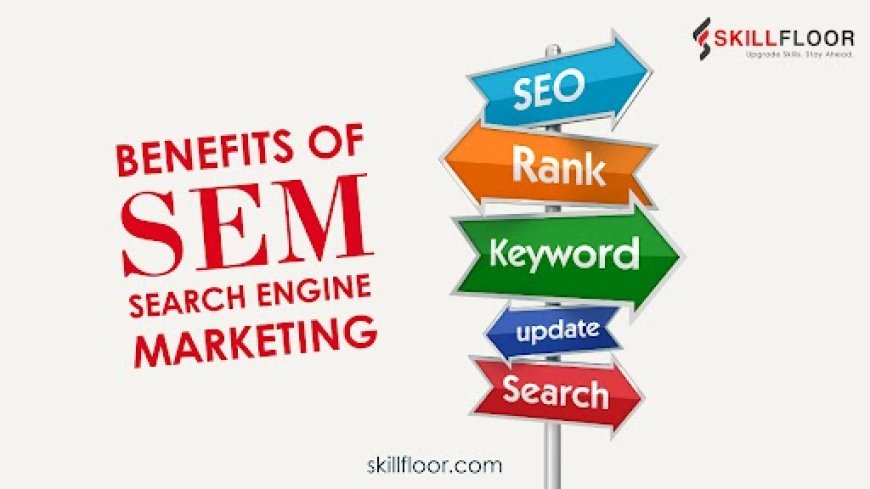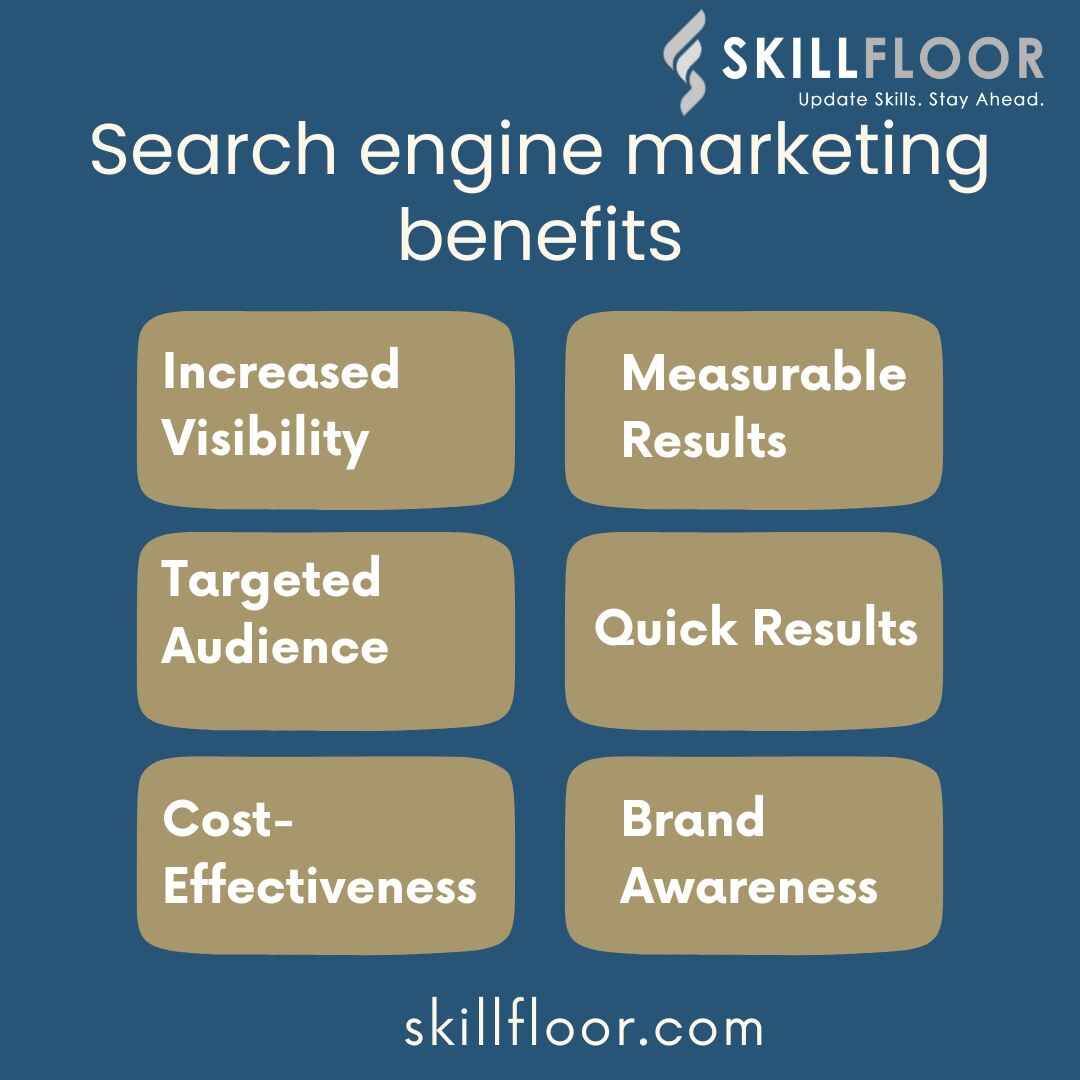Search engine marketing benefits
Discover the benefits of Search Engine Marketing: Get seen more, bring more people to your site, and make more sales. Find out how SEM can make your online presence better.

Businesses also gain a competitive edge by being able to quickly modify their plans based on real-time data and industry trends, which is an added benefit of search engine marketing (SEM). Because of its flexibility, campaigns may be continuously optimized for optimal efficacy and efficiency. In addition, SEM increases brand exposure by guaranteeing constant visibility in search results and strengthening brand awareness and confidence among prospective clients. SEM is an essential part of any complete digital marketing strategy because of these combined benefits of search engines, which increase online visibility, drive targeted visitors, and ultimately drive business growth.
To increase online visibility, a small boutique apparel company that is having trouble attracting customers invests in search engine marketing (SEM). They show up high in search results because they cater to the stylish people in their city. This tactic draws more local visitors to their physical store while increasing internet traffic and online purchases. SEM plays a key role in propelling the boutique's development both online and off by making it the go-to place for fashion fans.
What is search engine marketing?
Providing paid advertising to raise a website's exposure in search engine results pages (SERPs) is the goal of search engine marketing or SEM. It entails producing and refining advertisements that show up next to naturally occurring search results when consumers look for particular keywords associated with the goods or services offered by the advertiser. Pay-per-click (PPC) advertising is the standard method used by SEM. In this approach, advertisers bid on keywords and only pay when their ads are clicked. With the help of this type of marketing, companies can precisely target their audience, track the effectiveness of their campaigns, and accomplish several marketing goals, including boosting website traffic, lead generation, and sales.
How Does Search Engine Marketing Work?
-
Keyword Research: Advertisers conduct keyword research to identify the terms and phrases that potential customers are using when searching for products or services related to their business.
-
Ad Creation: Based on the keywords identified, advertisers create compelling and relevant ads that will be displayed in search engine results when users search for those keywords. These ads typically include a headline, description, and URL.
-
Bid Management: Advertisers bid on the keywords they want to target in their ads. The bid represents the maximum amount they are willing to pay for each click on their ad.
-
Ad Auction: When a user enters a search query that matches the keywords targeted by advertisers, a real-time auction takes place to determine which ads will be displayed. The auction considers factors such as bid amount, ad quality, and relevance.
-
Ad Placement: The search engine uses a combination of bid amount and ad quality (determined by factors like ad relevance, landing page experience, and expected click-through rate) to determine the placement of ads in the search results.
-
Ad Display: If an advertiser's bid is competitive and their ad meets the search engine's quality criteria, it will be displayed in a prominent position on the search results page when users search for the relevant keywords.
Types of Search Engine Marketing
-
Pay-per-click (PPC): PPC advertising allows advertisers to bid on keywords relevant to their business. They pay a fee each time their ad is clicked. Google Ads and Bing Ads are popular platforms for PPC advertising.
-
Display Advertising: Display advertising involves placing visual ads, such as banners or interactive ads, on websites within a network of publishers. These ads can target specific demographics, interests, or behaviors of users.
-
Shopping Ads: Shopping ads, also known as product listing ads (PLAs), display product images, prices, and store information in search engine results. They are particularly effective for e-commerce businesses looking to promote their products directly to potential customers.
-
Remarketing: Remarketing allows advertisers to target users who have previously visited their website but did not make a purchase. By displaying targeted ads to these users as they browse other websites or search engines, advertisers aim to re-engage them and encourage them to return and convert.
-
Local Search Ads: Local search ads are designed to promote businesses to local customers searching for products or services in their area. These ads appear in local search results and Google Maps, helping businesses attract nearby customers.
-
Video Ads: Video ads are displayed on video-sharing platforms like YouTube or within other video content. They can be skippable or non-skippable and are effective for reaching audiences through engaging visual content.
-
App Promotion Ads: App promotion ads are designed to drive app installs or engagement. They appear in search results or within other apps and encourage users to download or interact with the advertised app.
Search engine marketing benefits

-
Increased Visibility: SEM ensures that your website appears prominently in search engine results pages (SERPs), increasing visibility to potential customers actively searching for your products or services.
-
Targeted Audience: SEM allows precise targeting of demographics, locations, and user behaviors, ensuring that your ads reach the most relevant audience, and increasing the likelihood of conversion.
-
Cost-Effectiveness: SEM operates on a pay-per-click (PPC) model, meaning you only pay when users click on your ads. This cost-effective approach allows for better budget control and maximizes ROI.
-
Measurable Results: SEM platforms provide detailed analytics and tracking tools, allowing you to measure the performance of your campaigns in real time. You can track metrics such as clicks, impressions, conversions, and ROI, enabling data-driven decision-making and campaign optimization.
-
Quick Results: Unlike organic search engine optimization (SEO), which can take time to show results, SEM can generate immediate traffic and leads for your business once your ads are approved and live.
-
Brand Awareness: SEM increases brand visibility and awareness by ensuring that your ads are displayed prominently in search results, even if users don't click on them. This exposure helps reinforce brand recognition and trust among potential customers.
Challenges in search engine marketing
- Competition: Increased competition in the SEM landscape can lead to higher costs per click (CPC) and make it harder for smaller businesses to compete with larger advertisers, especially in highly competitive industries.
- Ad Fatigue: Users may become immune to ads over time, especially if they see the same ads repeatedly. Advertisers need to continuously refresh their ad creatives and messaging to avoid ad fatigue and maintain user engagement.
- Keyword Selection and Bidding: Choosing the right keywords to target and optimizing bids for maximum ROI can be challenging. Advertisers need to conduct thorough keyword research and regularly adjust their bidding strategies to ensure optimal performance.
- Ad Relevance and Quality Score: Search engines like Google use algorithms to evaluate the relevance and quality of ads. Low-quality ads with low relevance scores may receive lower ad placements or higher CPCs, making it essential for advertisers to maintain high ad quality and relevance.
- Ad Blocking: Some users employ ad-blocking software or browser extensions to prevent ads from appearing, reducing the effectiveness of SEM campaigns. Advertisers need to find alternative strategies to reach these users effectively.
- Ad Fraud: SEM campaigns may be susceptible to click fraud, where bots or malicious actors click on ads to drain advertisers' budgets or manipulate performance metrics. Advertisers need to implement measures to detect and mitigate click fraud effectively.
- Algorithm Changes: Search engines regularly update their algorithms, which can impact the performance of SEM campaigns. Advertisers need to stay informed about algorithm changes and adapt their strategies accordingly to maintain campaign effectiveness.
- Attribution Challenges: It can be challenging to accurately attribute conversions and sales to specific SEM campaigns, especially in multi-channel marketing environments. Advertisers need to use advanced attribution models and analytics tools to understand the full impact of their SEM efforts on overall business performance.
Many advantages are available to organisations through search engine marketing (SEM), such as improved brand awareness, cost-effectiveness, accurate audience targeting, measurable results, and speedy turnarounds. Because SEM can drive targeted traffic, generate leads, and ultimately support business growth, it is still a crucial part of any comprehensive digital marketing plan, even in the face of obstacles like competition, ad fatigue, and algorithm updates. Through the proactive resolution of these issues and efficient utilization of SEM, companies may optimize their digital footprint and effectively accomplish their marketing goals.




























































